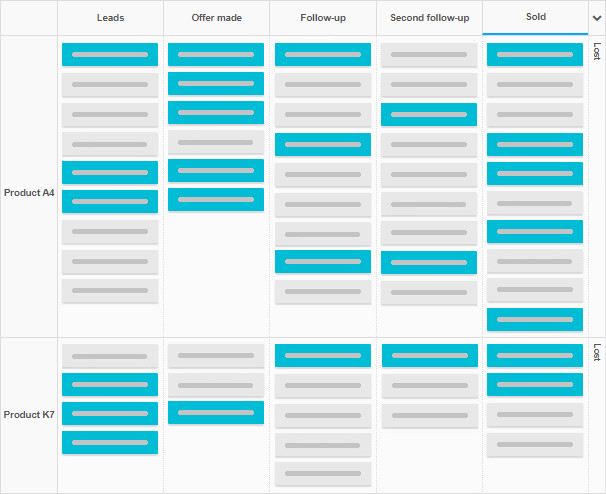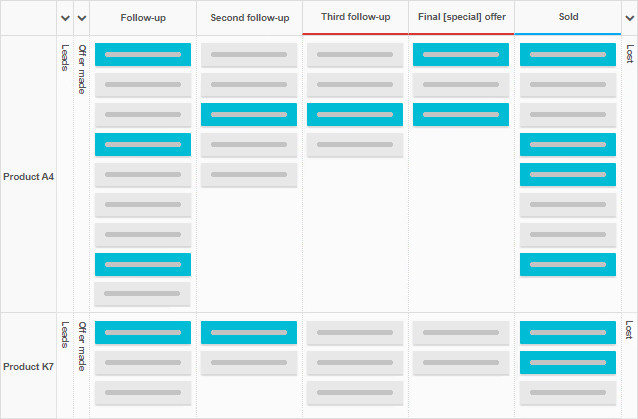Kanban in Business Management

It’s fair to associate Kanban with tracking the progress of a specific project, consisting of tasks. But since the method can follow virtually any kind of process, it also has a place in general business management.
Human resources management, long-term strategic planning, suppliers oversight, customer care, staying on top of correspondence, taxes, regulations, security, etc. - Kanban brings a generous dose of clarity to them all, helping to manage deadlines, and recognize blockers long before they result in financial loss. All this can add up to making your business more flexible, reliable, predictable, responsive, and Agile, simply because there is no area of business that does not benefit from easy prioritization and a high level of transparency offered by the Kanban method.
Kanban records your processes
Using the Kanban model for all aspects of your business builds a record of the operations and workflows in all areas. You automatically create a blueprint for the future and aid for new employees. Rather than having to outlay the way a specific department works, any team member can take a glimpse into the flow itself by watching their Kanban board. Seeing the nature of the work, the custom workflow that a team follows, the pace, the crucial areas of attention, etc.
Furthermore, a physical record of how a process goes is a solid place for you to find why, when, and how specific actions were taken. It helps to resolve disputes, find missing pieces of information, and identify responsibilities - all at the same time. Kanban can give you the big picture view of all aspects of your company’s operations.
Example
Your software development team has done a one-off open source project a while back. Since then, a portion of the team has been replaced, and no one recalls how the project was conducted, published, followed up, and maintained. But interest in it has resurfaced on the client-side. Go to your Kanban archive and find that project’s board: review what the process looked like, what was done, by whom and how, and take it from there.
View a Kanban for software development use case.
Kanban simplifies optimization

Tied to the above point is the ease with which you’ll be able to tell which process’ or department areas need improving. The immediately available way to do it is to view the specific project board. If items are piling up in one stage, then either there are too few people working on it, or they are not performing adequately, or the tasks come in with some inherent flaws, blocking the team. Either way, a bottleneck like this can be spotted right away and, once analyzed, resolved.
A more systematic way of seeing where given process stalls or excels is keeping and reviewing Kanban analytics, such as the Cumulative Flow Diagram or the Lead and Cycle Time. Gathering data for a visual board is not too difficult, but if an online board is used, these metrics will generate for your boards automatically. The metrics read your process throughput, the average time different types of work get done within, how well the process does over time - is it continuing at a steady pace or experiencing jumps in productivity and periods of stagnation, and more.
Example
Your finance team noted a drop in last quarter’s revenue. Naturally, you want to know what happened and stop the trend. To begin, track the flow on your sales and development boards to see if a pattern leading you to fewer sales or slower development emerges. Has progress in delivering ordered products halted? If so, why? Have there been fewer sales? If yes, what is the feedback from sales, what do they hear from their leads?
View a Kanban for company finance management example video.
Kanban improves your ability to change
With Agile Kanban, your team is free to design the process as representing their work accurately and modify it as and when needed. If each group in your firm manages their own process, it means one thing: freedom and ease when adapting to change. Whether it’s due to customer request, or due to integration with other flows or - most likely - due to a change in the market - having a say in what the team’s process looks like is imperative to them keeping it valid, optimal, and coherent with the customer and company needs.
What’s more, team-owned processes become more open to feedback (from all directions, client and internal) than flows designated by managers disconnected from the specific area of work. And more feedback means faster and more frequent improvements!

Example
Your sales team makes two courteous attempts to offer the best deal to prospective buyers and keep them interested in purchasing the product. After that, they make themselves available for questions and feedback but stop pestering the interested parties. Their board looks like this:
 After you note a drastic drop in sales, you request the team to experiment with reaching out to prospects two more times. Once just asking for feedback, and then offering a significantly better deal as a last call of action.
After you note a drastic drop in sales, you request the team to experiment with reaching out to prospects two more times. Once just asking for feedback, and then offering a significantly better deal as a last call of action.
 Should it later turn out that it was not the price that stopped the buyers, the workflows return to the standard two follow-ups and adopts a change in the factually problematic area.
Should it later turn out that it was not the price that stopped the buyers, the workflows return to the standard two follow-ups and adopts a change in the factually problematic area.
View a detailed Kanban for sales use case.
Kanban liberates the teams
Just like, e.g., a software development team becomes able to apply 100% focus to one task before moving on to another, thanks to Kanban’s WIP limits, the same freedom to concentrate is available to all other professions. To your accounting, marketing, support, procurement, hiring, and all other personnel. You may get surprised how, once someone experiences the single-task focus, they are never going to give it up. Aside from a very few exceptions, multi-tasking doesn’t help productivity. Asking someone to treat all incoming requests with equally high priority and work on them simultaneously means you’re accepting that progress will be slow and erroneous and that the worker will get frustrated, distracted, and annoyed. Meanwhile, asking them to adopt a single item focus and not start another task until there is one ongoing means more completed tasks at the end of the day, a calmer workplace, and happier team members.
WIP limits are one of the game-changers when adopting Kanban. Let members of all your teams reap their benefits.
Example
Your security team does automatic and manual system health checks. It also receives internal and external problem reports. All source reports make it to the Kanban board with an assigned urgency value (1 to 5). Team members know to work on level 5 issues first, and when finished, to proceed to 4, 3, and so on, so for as long as there are enough level-5 tasks, the lower ones stay dormant. The crucial rule is that each member can only start a new item after the previously started one was finished, ensuring 100% efficient focus on the task at hand, creating an environment likely to result in as little need for rework as possible.
View a Kanban for an IT management and security process use case.
Kanban minimizes the need for meetings

Consider the total time all of your company members spend in meetings every week. You probably know perfectly well that more-less half of that time is spent waiting for everyone to gather, repeat information that was given before, and address managerial issues that need resolving by one specific person - not a team.
Now think about how this total time changes when all your teams’ processes and their current states are available in a visual, easy to take in form. No longer do you need to ask for an item’s status, nor discuss issues that are not yours to resolve - just take a look at the board to see where each item is at and assign resolving a problematic task to the person best suited for the job. That means you can limit your team meetings solely to social interactions, keeping you connected rather than repeatedly discussing matters already documented elsewhere.
Example
You want an update on a given project, but the team working on it is placed in different time zones. Arranging a call at a time that works for everyone will take days. All you need to do instead is open the project board, see what tasks are ongoing, who works on them (if there are specific problems, they too can make it to the task information for all to see), and what got done already. Review the Lead & Cycle Time to see how fast work is progressing. It will give you an idea of when you should expect the project to complete. Still, left with questions on specific aspects? Open the appropriate tasks and ask the responsible worker a question. Once they’re back, you’ll have your answers. Keep the long-haul cross-time-zone meeting scheduling for special team events only, saving everyone’s time and effort.
View a Kanban for remote teamwork management example video.
Did you know?
The Kanban Tool® service delivers virtual Kanban boards that can be customized to any type of process. It has no learning curve and a ton of optional features. Use Kanban Tool to visualize and share processes with the team, comment on tasks and review the automatically generated Analytics. Simplify business management now!
Kanban lets you focus on customer values
With Kanban workflows based on completion stages, it will be easier for your customer-facing teams to define what the clients value the most. With that, teams can arrange the process to maximize value while limiting all actions and information processing with no impact on the client. Listening to the client and directing most of your effort towards what they pay attention to will keep the client happy and maintain low levels of waste on your end.
Example
Your customer support team needs no involvement in detailed product development, as it offers no actionable information for their daily work with the clients. They only need to know the best, fastest ways to address common issues and queries. Notifications of product changes are required not earlier than when they are published. This way, you limit confusion, allowing clarity and focus, not ambivalence.
View a Kanban for customer support use case.
Adopting Kanban for all aspects of your business management can make your processes start to seem a lot less complex and sluggish than before. Remember that to control your business, you need to know it perfectly well, and there is no easier way to achieve that than mapping it out visually for all the involved members to see.
Using Kanban boards for your business management, planning, maintenance, and development will bring you:
- Improved process throughput, due to better jobs control,
- Better tasks flow and more transparency; because of Kanban’s visual nature and ease of data intake that it offers,
- Higher product and service quality, thanks to the easier focus and less unnecessary rework,
- Happier teams and more satisfied clients - as a result of more manageable flows for your team and better response to what the clients value.